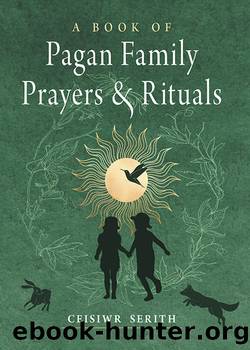A Book of Pagan Family Prayers and Rituals by Serith Ceisiwr;

Author:Serith, Ceisiwr;
Language: eng
Format: epub
ISBN: 6955356
Publisher: Red Wheel/Weiser
Samhain Customs
Samhain Eve is the night of death, when the fairy mounds open and the dead and the old gods walk the earth. On this night, gifts of food and drink are left out for them, in either appeasement or greeting. It's the night when the veil is thin between our world and that of the gods and spirits and anyone may pass throughâin either direction. Many Samhain customs are designed to protect the home from these spirits or the fairies, although some Pagans welcome them, and so either don't keep some of these customs or reinterpret them. For instance, the jack-o'-lantern, far from scaring off spirits, may be seen as evidence of spirits in our midst.
In ancient Ireland, Samhain was actually part of a weeklong celebration that was divided into three parts: the three days before it, the day itself, and the three days after it. The feasting was long and well-celebrated. In remembrance of this, your celebration should extend for at least three days. That's why there are three rituals given hereâone for the Night of Harvest's End, one for the Night of the Animal Spirits, and one for the Night of the Ancestorsâeach of which deals with a different aspect of Samhain. Unlike other festivals, where I give several rituals to choose from, all three of these are meant to be performed, one on each of three days. It's best to perform them on consecutive days, but, depending on local custom, you may have to reschedule one of them so as not to conflict with trick-or-treating.
The origin of trick-or-treating has been the subject of a lot of speculation, some of it based on evidence and some not. I wouldn't like to be the one more person saying âthis is how it began.â I don't think we can know for sure. We do know, though, that everywhere in the ancient world, the days before the New Year and feasts of the dead were a time of ritual chaos when the world dissolved, the cosmos disintegrated, and the human community allowed itself to fall apart as well. There were celebrations with costumes, general lawlessness, children's revolts, and trick-or-treating. The meaning seems to have been that with the old year dying and the new one not yet begun, the old rules were dead and the new ones not yet in place. It was thus a time for both fear and merrymaking.
We know that, in the British Isles, there are many customs associated with particular days that involve going from door to door collecting goodies: Pace Egging, Guy Fawkes, caroling, and, in areas influenced by the Gaels (or, in modern times, by Americans), Halloween. These customs died out in early America, but the influx of Irish immigrants during the Potato Famine was probably responsible for reviving them. This is conjecture, but the traditions are old, and probably pre-Christian.
Secular Halloween customs are therefore quite appropriate, and you can take part in them with a good conscience. As well as taking part in
Download
This site does not store any files on its server. We only index and link to content provided by other sites. Please contact the content providers to delete copyright contents if any and email us, we'll remove relevant links or contents immediately.
Spare by Prince Harry The Duke of Sussex(4808)
For Baby's Sake(4515)
Tuesdays with Morrie by Mitch Albom(4415)
Machine Learning at Scale with H2O by Gregory Keys | David Whiting(3679)
Never by Ken Follett(3556)
The Five People You Meet in Heaven by Mitch Albom(3342)
Fairy Tale by Stephen King(2985)
Reminders of Him: A Novel by Colleen Hoover(2785)
Will by Will Smith(2599)
The Clitoral Truth: The Secret World at Your Fingertips by Rebecca Chalker(2591)
Tuesdays With Morrie by Mitch Albom(2583)
Borders by unknow(2123)
The Body Keeps the Score by Bessel van der Kolk MD(2088)
Cruel to Be Kind by Cathy Glass(2057)
Friends, Lovers, and the Big Terrible Thing by Matthew Perry(2020)
The Stranger in the Lifeboat by Mitch Albom(1948)
Finding Chika by Mitch Albom(1889)
Love on the Brain by Ali Hazelwood(1834)
New Morning Mercies: A Daily Gospel Devotional by Paul David Tripp(1823)
